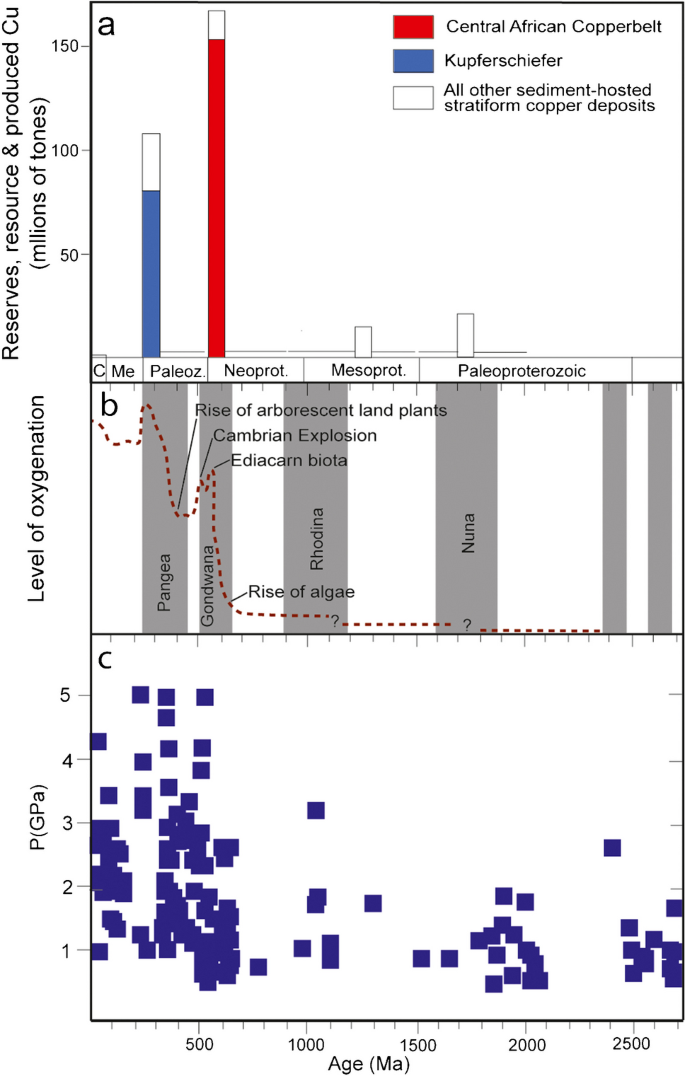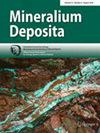The role of supermountain belts and climatic controls on the genesis of copper deposits in the Kupferschiefer and the Central African Copperbelt
IF 4.4
2区 地球科学
Q1 GEOCHEMISTRY & GEOPHYSICS
引用次数: 0
Abstract
Abstract Sedimentary rock–hosted stratiform copper deposits are the world’s second largest source of copper and the largest source of cobalt, with about 73% of the copper occurring in two basins: the Katangan Basin (Central African Copperbelt) and the Permian Basin (Kupferschiefer). Why these two sedimentary basins are so highly endowed in copper is puzzling because sedimentary rock–hosted stratiform copper deposits have formed since the Paleoproterozoic and they all share remarkably similar ore mineralogy, host-rock characteristics and basin settings. We suggest that this discrepancy is due to the development of these two basins close to the bases of ~ 8000-km-long supermountain belts. The supermountain belts were instrumental in raising oxygen levels in Earth’s atmosphere, as well as providing a voluminous source of groundwater and a powerful and long-lived driver for the fluid-flow system. The elevated oxygen levels facilitated the diagenetic processes that converted copper-bearing labile minerals to amorphous iron-oxides and smectite and then in turn to hematite and illite. When oxidized brines flushed through the basin successions, the liberated copper was transported to units containing carbon-rich mudstone and the metals were deposited. For the Katangan Basin, development of the Transgondwanan supermountain belt along its margins between about 525 and 510 Ma explains the delay of several hundreds of millions of years between basin formation and mineralization in the Central African Copperbelt. In contrast, development of the Mid-Pangean supermountain belt formed penecontemporaneous with the Permian Basin explains the similarity in timing between basin formation and mineralization in the Kupferschiefer.

超山带和气候对Kupferschiefer和中非铜带铜矿床成因的控制作用
沉积岩层状铜矿是世界上第二大铜源和最大的钴源,约73%的铜产自两个盆地:加丹甘盆地(中非铜带)和二叠纪盆地(库普弗希弗)。为什么这两个沉积盆地的铜含量如此之高令人费解,因为沉积岩层状铜矿床形成于古元古代,它们都具有非常相似的矿石矿物学、寄主岩特征和盆地环境。我们认为这种差异是由于这两个盆地的发育靠近约8000公里长的超山带的基底。超山带在提高地球大气中的氧气含量方面发挥了重要作用,同时为地下水提供了大量来源,并为流体流动系统提供了强大而持久的驱动力。高氧水平促进了含铜不稳定矿物转化为无定形氧化铁和蒙脱石,然后转化为赤铁矿和伊利石的成岩过程。当氧化盐水在盆地序列中冲刷时,释放出来的铜被输送到富含碳的泥岩单元中并沉积金属。对于加丹甘盆地,在525 ~ 510 Ma之间沿其边缘发育的Transgondwanan超山带解释了中非铜带盆地形成和成矿之间数亿年的延迟。与二叠纪盆地形成准同生的中盘古超山带的发育,解释了Kupferschiefer盆地形成与成矿时间的相似性。
本文章由计算机程序翻译,如有差异,请以英文原文为准。
求助全文
约1分钟内获得全文
求助全文
来源期刊

Mineralium Deposita
地学-地球化学与地球物理
CiteScore
11.00
自引率
6.20%
发文量
61
审稿时长
6 months
期刊介绍:
The journal Mineralium Deposita introduces new observations, principles, and interpretations from the field of economic geology, including nonmetallic mineral deposits, experimental and applied geochemistry, with emphasis on mineral deposits. It offers short and comprehensive articles, review papers, brief original papers, scientific discussions and news, as well as reports on meetings of importance to mineral research. The emphasis is on high-quality content and form for all articles and on international coverage of subject matter.
 求助内容:
求助内容: 应助结果提醒方式:
应助结果提醒方式:


